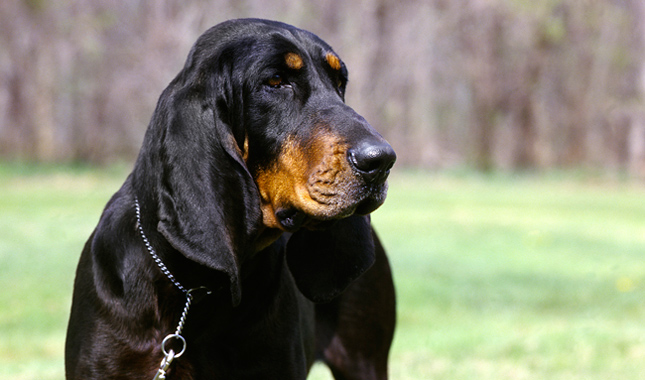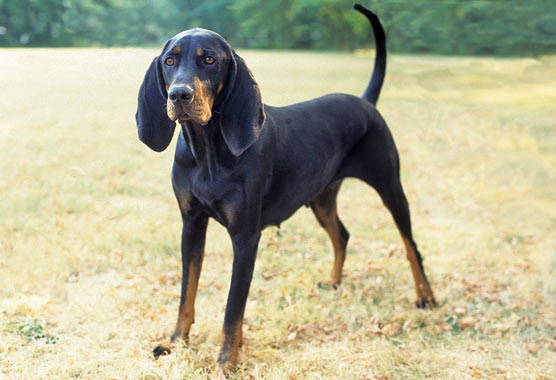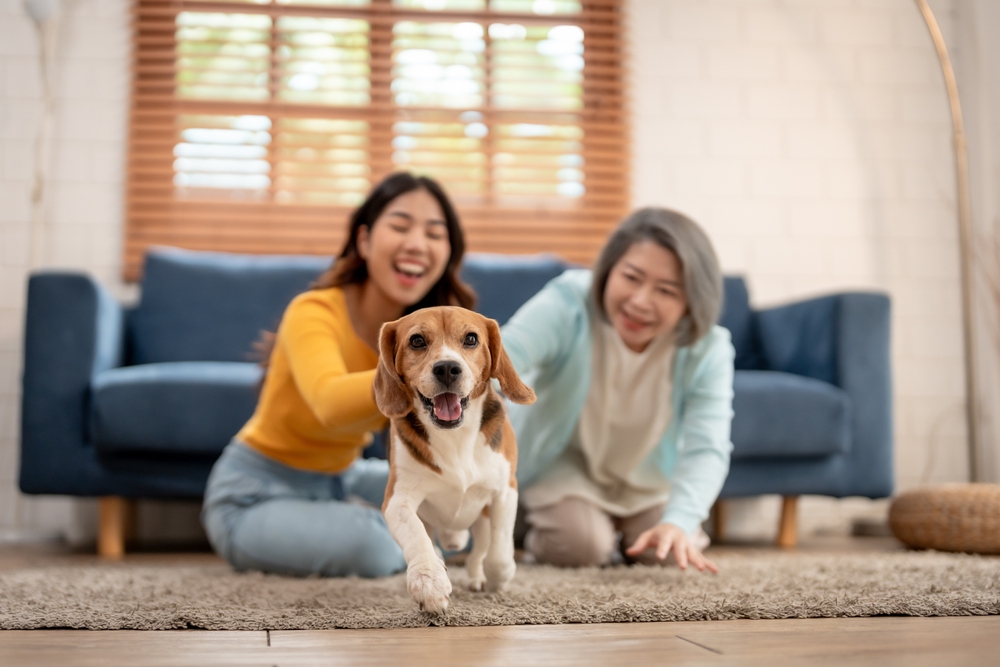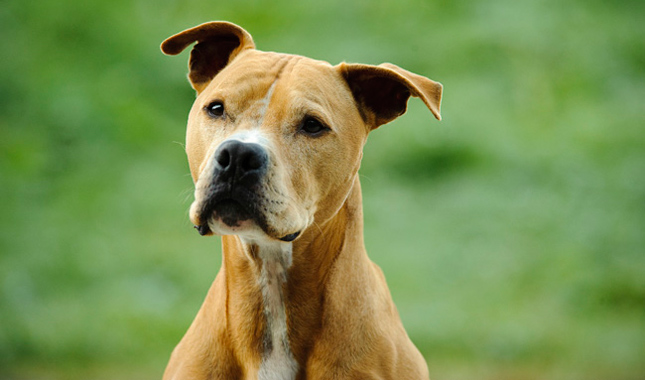Black and Tan Coonhound
Published on July 05, 2011
Breed Details
- Height: 23 to 27 inches at the shoulder
- Weight: 65 to 100 pounds
Breed Characteristics
Adaptability
Trainability
Grooming
Apartament Friendly
Child Friendly
Shedding Level
Dog Friendly
Exercise Needs
Territorial
Barking Tendencies
Health Issues
Social Needs
Energy Level
Affectionate
Watchdog Instincts
Cat Friendly
Intelligence
Stranger Friendly
The Black and Tan Coonhound is American born and bred. He was developed in the southern United States in the late 18th century from Foxhounds and probably an infusion of Bloodhound, from whom he gets his coloring, long ears and large-boned body, not to mention his famous cold nose: the ability to find and follow an old trail with barely any scent left to it. Black and Tans hunt raccoons, of course, and possums, but they’re also happy to trail bigger game such as deer, mountain lions and bears. They’re not especially fast on the trail, but they are unwavering. Once they tree their quarry, they bark to alert the hunter.
The handsome Black and Tan is happy-go-lucky and adaptable. Calm by nature, he has an outgoing, friendly temperament. He’s a good friend to children, but if you have toddlers, consider adopting an adult Black and Tan, who will be less rambunctious than a puppy. Black and Tans get along well with other animals, cats included, especially if they’re brought up with them. Their exercise needs are moderate. Plan on giving a Black and Tan at least a half hour walk once or twice daily, plus several shorter outings throughout the day. Remember that a tired Black and Tan is a good Black and Tan.
Always walk your Black and Tan on leash to ensure that he doesn’t run off after an interesting scent. He also needs a securely fenced yard to keep him contained when you’re not home. He loves to hunt and will go off on his own if given half a chance.
Black and Tans can adapt to living indoors or outdoors, but they love their people and will pine without human companionship. A Black and Tan needs plenty of companionship and activity to be happy. If that activity involves following some kind of scent trail, so much the better. Even if you don’t hunt him, consider getting involved in tracking or search and rescue. He’s also a great hiking companion if you don’t mind going at a slow pace so he can follow a trail now and then.
This is a large breed, standing 23 to 27 inches tall and weighing 65 to 100 pounds. Black and Tans have short, dense, easy-care coats in coal black with rich tan points above the eyes, on the sides of the muzzle, chest, legs and thigh area, and black pencil-lie markings on the toes. They need only a weekly brushing or wipedown, plus regular nail trimming, ear cleaning and tooth brushing.
Be aware as well that the Black and Tan Coonhound has what can best be described as a musty odor. Regular baths can help keep the odor under control, but it’s something you should be prepared to live with.
The drawbacks? Coonhounds can be loud and stubborn. Unless you live about five miles from your nearest neighbors, they’re going to hear your Coonhound when he gets excited about finding a good scent. Begin training early and use positive reinforcement techniques. The B&T especially appreciates food rewards.
Other Quick Facts
- The Black and Tan was the first Coonhound breed admitted to AKC registration.
- The Black and Tan is known as a “trail and tree hound,” meaning he can not only find his quarry but also tree it.
- This breed has a black coat with tan points above the eyes, on the sides of the muzzle, and on the chest, legs and breeching (the upper thigh area), plus black pencil markings on the toes.
The History of Black and Tan Coonhounds
This is one of the few all-American breeds. Black and Tan Coonhounds date to the 18th century and were developed in the southern United States, probably by blending Foxhounds and Bloodhounds. The Bloodhound bequeathed his long ears to the Black and Tan, not to mention his famous ability to find and follow an old, cold trail.
The American Kennel Club welcomed the Black and Tan in 1945. It was the first of the Coonhounds to achieve AKC recognition. Black and Tan Coonhounds currently rank 91st among the breeds registered by the AKC, up from 123rd a decade ago.
Black and Tan Temperament and Personality
The Black and Tan is a friendly, outgoing dog who should never be aggressive toward people or other dogs. A good word to describe him is happy-go-lucky. He shines in a number of arenas, from field to show ring to family companion. He’s great with kids, although he might be a bit too rambunctious for toddlers, and he can get along with other pets such as cats if he’s raised with them.
Black and Tans are typical scenthounds. They love to find a good scent and follow it, so it’s essential to have a securely fenced yard to keep them from wandering off and going hunting on their own. He’ll enjoy long, meandering, on-leash walks that give him plenty of sniffing time. At home, he will be happy to share your sofa or bed with you as you watch the big game or your favorite reality show. Be sure you don’t leave food out within his reach, or he’ll snarf it before you know it.
Train a Black and Tan with patience and positive reinforcement. Food rewards will definitely get and keep his attention. Training sessions should be short and fun so he doesn’t lose interest or get discouraged. Try not to let him get away with anything you don’t want him to do; once he learns something, good or bad, it’s difficult to dislodge it from his brain. And you will often find that he is creative in his interpretation of commands; hounds are known to put their own special twist on obedience or other activities.
Start training your puppy the day you bring him home. Even at eight weeks old, he is capable of soaking up everything you can teach him. Don’t wait until he is 6 months old to begin training or you will have a more headstrong dog to deal with. If possible, get him into puppy kindergarten class by the time he is 10 to 12 weeks old, and socialize, socialize, socialize. However, be aware that many puppy training classes require certain vaccines (like kennel cough) to be up to date, and many veterinarians recommend limited exposure to other dogs and public places until puppy vaccines (including rabies, distemper and parvovirus) have been completed. In lieu of formal training, you can begin training your puppy at home and socializing him among family and friends until puppy vaccines are completed.
Talk to the breeder, describe exactly what you’re looking for in a dog, and ask for assistance in selecting a puppy. Breeders see the puppies daily and can make uncannily accurate recommendations once they know something about your lifestyle and personality. Whatever you want from a Black and Tan, look for one whose parents have nice personalities and who has been well socialized from early puppyhood.
What You Need to Know About Black and Tan Health
All dogs have the potential to develop genetic health problems, just as all people have the potential to inherit a particular disease. Run, don’t walk, from any breeder who does not offer a health guarantee on puppies, who tells you that the breed is 100 percent healthy and has no known problems, or who tells you that her puppies are isolated from the main part of the household for health reasons. A reputable breeder will be honest and open about health problems in the breed and the incidence with which they occur in her lines.
Black and Tan Coonhounds are generally healthy, but they have some health conditions you should be aware of: hip dysplasia; and eye problems such as entropion and ectropion. Some Black and Tan Coonhounds have been diagnosed with hemophilia B. The breed's propensity to follow a trail may predispose them to Coonhound paralysis, an inflammation of the nerves that may be associated with exposure to raccoons.
Not all of these conditions are detectable in a growing puppy, and it is impossible to predict whether an animal will be free of these maladies, which is why you must find a reputable breeder who is committed to breeding the healthiest animals possible. They should be able to produce independent certification that the parents of the dog (and grandparents, etc.) have been screened for common defects and deemed healthy for breeding. That’s where health registries come in.
The American Black and Tan Coonhound Club, which is the American Kennel Club parent organization for the breed in the United States, participates in the Canine Health Information Center Program. For a Black and Tan Coonhound to achieve CHIC certification, he must have a hip clearance from the Orthopedic Foundation for Animals or PennHIP, certification from the Canine Eye Registry Foundation that the eyes are healthy, and an OFA cardiac evaluation.
Breeders must agree to have all test results, positive or negative, published in the CHIC database. A dog need not receive good or even passing scores on the evaluations to obtain a CHIC number, so CHIC registration alone is not proof of soundness or absence of disease, but all test results are posted on the CHIC website and can be accessed by anyone who wants to check the health of a puppy’s parents. If the breeder tells you she doesn't need to do those tests because she's never had problems in her lines and her dogs have been "vet checked," then you should go find a breeder who is more rigorous about genetic testing.
Careful breeders screen their breeding dogs for genetic disease and breed only the healthiest and best-looking specimens, but sometimes Mother Nature has other ideas and a puppy develops one of these diseases despite good breeding practices. Advances in veterinary medicine mean that in most cases the dogs can still live a good life. If you’re getting a puppy, ask the breeder about the ages of the dogs in her lines and what they died of.
Not every Black and Tan visit to the veterinarian is for a genetic problem. Dogs with floppy ears can be prone to ear infections, so check the ears weekly, clean them if necessary, and keep them dry to eliminate the warm, moist environment in which yeast and bacteria thrive. Coonhounds who go hunting may tear off a toenail, break a toe, develop split pads on their feet or damage their ears. Check them over carefully for ticks after they’ve been out in the woods or fields.
Remember that after you’ve taken a new puppy into your home, you have the power to protect him from one of the most common health problems: obesity. Keeping a Black and Tan at an appropriate weight is one of the easiest ways to extend his life. Make the most of your preventive abilities to help ensure a healthier dog for life
The Basics of Black and Tan Grooming
The Black and Tan Coonhound has a short, dense coat. It’s easy to groom, but it sheds a lot. Brush the coat with a hound mitt or rubber curry brush one to three times a week to remove dead hair and distribute skin oils.
Regular brushing should keep your Coonhound pretty clean, but if he has a houndy odor you can bathe him to help reduce the smell. Be sure to rinse thoroughly. Shampoo left on the coat can cause dry, flaky skin.
Keep those droopy ears clean and dry to prevent bacterial or yeast infections from taking hold. Plenty of Coonhounds like to swim, so dry the ears thoroughly any time they’ve been in the water.
The rest is basic care. Trim the nails as needed, usually every few weeks. Brush the teeth frequently for good overall health and fresh breath.
Finding a Black and Tan Coonhound
Whether you want to go with a breeder or get your dog from a shelter or rescue, here are some things to keep in mind.
Choosing a Black and Tan Coonhound Breeder
Finding a good breeder is the key to finding the right puppy. A good breeder will match you with the right puppy, and will without question have done all the health certifications necessary to screen out health problems as much as is possible. He or she is more interested in placing pups in the right homes than in making big bucks.
Good breeders will welcome your questions about temperament, health clearances and what the dogs are like to live with and come right back at you with questions of their own about what you’re looking for in a dog and what kind of life you can provide for him. A good breeder can tell you about the history of the breed, explain why one puppy is considered pet quality while another is not, and discuss what health problems affect the breed and the steps she takes take to avoid those problems. A breeder should want to be a resource for you throughout your dog’s life.
Look for more information about the Black and Tan and start your search for a good breeder at the website of the American Black and Tan Coonhound Club. Choose a breeder who has agreed to abide by the ABTCC’s code of ethics, which prohibits the sale of puppies to or through pet stores and calls for the breeder to obtain recommended health clearances on dogs before breeding them.
Avoid breeders who only seem interested in how quickly they can unload a puppy on you and whether your credit card will go through. Breeders who offer puppies at one price “with papers” and at a lower price “without papers” are unethical and should be reported to the American Kennel Club. You should also bear in mind that buying a puppy from websites that offer to ship your dog to you immediately can be a risky venture, as it leaves you no recourse if what you get isn’t exactly what you expected. Put at least as much effort into researching your puppy as you would into choosing a new car or expensive appliance. It will save you money in the long run.
Many reputable breeders have websites, so how can you tell who’s good and who’s not? Red flags include puppies always being available, multiple litters on the premises, having your choice of any puppy, and the ability to pay online with a credit card. Those things are convenient, but they are almost never associated with reputable breeders.
Whether you’re planning to get your new best friend from a breeder, a pet store, or another source, don’t forget that old adage “let the buyer beware”. Disreputable breeders and facilities that deal with puppy mills can be hard to distinguish from reliable operations. There’s no 100% guaranteed way to make sure you’ll never purchase a sick puppy, but researching the breed (so you know what to expect), checking out the facility (to identify unhealthy conditions or sick animals), and asking the right questions can reduce the chances of heading into a disastrous situation. And don’t forget to ask your veterinarian, who can often refer you to a reputable breeder, breed rescue organization, or other reliable source for healthy puppies.
The cost of a Black and Tan puppy varies depending on the breeder’s locale, whether the pup is male or female, what titles his parents have, and whether he is best suited for the show ring or a pet home. The puppy you buy should have been raised in a clean home environment, from parents with health clearances and conformation (show) and, ideally, field titles to prove that they are good specimens of the breed. Puppies should be temperament tested, vetted, dewormed, and socialized to give them a healthy, confident start in life.
Before you decide to buy a puppy, consider whether an adult Black and Tan Coonhound might better suit your needs and lifestyle. Puppies are loads of fun, but they require a lot of time and effort before they grow up to become the dog of your dreams. An adult may already have some training and will probably be less active, destructive and demanding than a puppy. With an adult, you know more about what you’re getting in terms of personality and health and you can find adults through breeders or shelters. If you are interested in acquiring an older dog through breeders, ask them about purchasing a retired show dog or if they know of an adult dog who needs a new home. If you want to adopt a dog, read the advice below on how to do that.
Adopting a Dog From a Black and Tan Coonhound Rescue or Shelter
There are many great options available if you want to adopt a dog from an animal shelter or breed rescue organization. Here is how to get started.
1. Use the Web
Sites like Petfinder and Adopt-a-Pet.com can have you searching for an Black and Tan in your area in no time flat. The site allows you to be very specific in your requests (housetraining status, for example) or very general (all the Black and Tans available on Petfinder across the country). AnimalShelter.org can help you find animal rescue groups in your area. Also some local newspapers have “pets looking for homes” sections you can review.
Social media is another great way to find a dog. Post on your Facebook page that you are looking for a specific breed so that your entire community can be your eyes and ears.
2. Reach Out to Local Experts
Start talking with all the pet pros in your area about your desire for an Black and Tan. That includes vets, dog walkers, and groomers. When someone has to make the tough decision to give up a dog, that person will often ask her own trusted network for recommendations.
3. Talk to Breed Rescue
Networking can help you find a dog that may be the perfect companion for your family. You can also search online for other Black and Tan rescues in your area. Most people who love Black and Tans love all Black and Tans. That’s why breed clubs have rescue organizations devoted to taking care of homeless dogs. The Black and Tan Club of America’s rescue network help you find a dog that may be the perfect companion for your family. You can also search online for other Black and Tan rescues in your area.
The great thing about breed rescue groups is that they tend to be very upfront about any health conditions the dogs may have and are a valuable resource for advice. They also often offer fostering opportunities so, with training, you could bring a Black and Tan home with you to see what the experience is like.
4. Key Questions to Ask
You now know the things to discuss with a breeder, but there are also questions you should discuss with shelter or rescue group staff or volunteers before you bring home a pup. These include:
What is his energy level?
How is he around other animals?
How does he respond to shelter workers, visitors and children?
What is his personality like?
What is his age?
Is he housetrained?
Has he ever bitten or hurt anyone that they know of?
Are there any known health issues?
Wherever you acquire your Black and Tan, make sure you have a good contract with the seller, shelter or rescue group that spells out responsibilities on both sides. Petfinder offers an Adopters Bill of Rights that helps you understand what you can consider normal and appropriate when you get a dog from a shelter. In states with “puppy lemon laws,” be sure you and the person you get the dog from both understand your rights and recourses.
Puppy or adult, take your Black and Tan to your veterinarian soon after adoption. Your veterinarian will be able to spot problems, and will work with you to set up a preventive regimen that will help you avoid many health issues.











